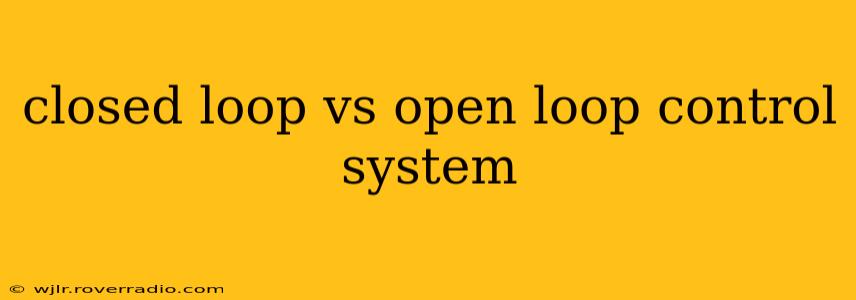Understanding the differences between closed-loop and open-loop control systems is crucial for anyone working with automation, robotics, or any system requiring precise control. While both aim to maintain a desired output, they achieve this in fundamentally different ways. This guide will delve into the core distinctions, providing real-world examples and addressing common questions.
What is an Open Loop Control System?
An open-loop control system, also known as an open-loop system or non-feedback control system, operates without feedback. It follows a predetermined sequence of actions without monitoring the actual output to make adjustments. The system simply executes its programmed instructions regardless of the outcome.
How it works: The desired input is provided to the system, and the system's output is solely determined by the input and the system's inherent characteristics. There's no mechanism to compare the actual output with the desired output and correct any deviations.
Examples of Open Loop Control Systems:
- Washing Machine Timer: A simple washing machine timer operates on a preset schedule. It doesn't check if the clothes are actually clean; it simply follows the programmed wash cycle.
- Traffic Light System: A basic traffic light system follows a pre-programmed sequence of green, yellow, and red lights regardless of traffic volume.
- Toaster: A toaster browns bread based on a pre-set time. It doesn't measure the level of browning and adjust accordingly.
Advantages of Open Loop Control Systems:
- Simplicity: They are simpler in design and less expensive to implement.
- Easy to understand and maintain: Their straightforward operation makes them easy to understand and maintain.
Disadvantages of Open Loop Control Systems:
- Susceptible to disturbances: External factors and variations in the system's characteristics can significantly affect the output accuracy and consistency.
- Lack of precision: They lack precision and are unsuitable for applications requiring high accuracy.
What is a Closed Loop Control System?
A closed-loop control system, also known as a closed-loop system, feedback control system, or servo-mechanism, uses feedback to regulate its output. It continuously monitors the actual output and compares it to the desired output. Any difference (error) is used to adjust the input, ensuring the output remains as close as possible to the desired value.
How it works: The system's output is measured using a sensor and compared with the desired setpoint. The difference (error) is then fed back to a controller, which adjusts the input to minimize the error. This continuous feedback loop ensures the system's output tracks the desired value accurately.
Examples of Closed Loop Control Systems:
- Cruise Control in a Car: The cruise control system continuously monitors the car's speed and adjusts the throttle to maintain the set speed.
- Thermostat: A thermostat monitors the room temperature and adjusts the heating or cooling system to maintain the desired temperature.
- Robot Arm: A robot arm uses feedback from sensors to accurately position itself and perform precise movements.
Advantages of Closed Loop Control Systems:
- High Accuracy: They provide high accuracy and precision in maintaining the desired output.
- Robustness: They are less sensitive to disturbances and variations in the system's characteristics.
- Self-Correcting: They automatically correct for errors, ensuring the system's output remains close to the desired value.
Disadvantages of Closed Loop Control Systems:
- Complexity: They are more complex and expensive to design and implement.
- Potential for instability: Improper design or tuning can lead to instability and oscillations in the system's output.
What are the key differences between open loop and closed loop control systems?
| Feature | Open Loop System | Closed Loop System |
|---|---|---|
| Feedback | No feedback | Feedback is essential |
| Accuracy | Low accuracy | High accuracy |
| Sensitivity to Disturbances | Highly sensitive | Less sensitive |
| Complexity | Simple | Complex |
| Cost | Less expensive | More expensive |
| Stability | Generally stable | Potential for instability if not properly tuned |
What are some real-world applications of each type of control system?
This has been addressed above in the advantages and disadvantages sections, but to reiterate: open loop systems are ideal for simpler applications where precise control isn't critical (like a washing machine timer). Closed-loop systems excel in applications demanding high accuracy and robustness (like cruise control or thermostats).
Which type of control system is better?
There's no universally "better" type of control system. The optimal choice depends entirely on the specific application's requirements. If high accuracy and robustness are paramount, a closed-loop system is necessary. If simplicity and low cost are prioritized, and precise control isn't crucial, an open-loop system might suffice.
This comprehensive guide provides a solid foundation for understanding the core differences between open-loop and closed-loop control systems, enabling you to make informed decisions regarding their implementation in various applications.
